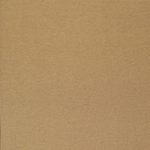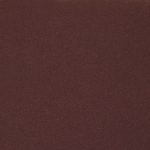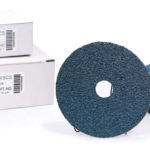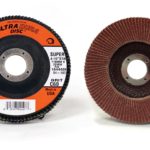Why are there so many different types of sandpaper materials? Like all things, better material replaces the old. Currently, there are 5 main abrasive materials used on sandpaper with unique strengths and weaknesses that make them suitable for a particular job.
Garnet

Garnet describes a group of natural, silicate minerals containing a range of materials, from gemstones to abrasives. As abrasives, garnet particles fracture during use, in a process called friability, providing new cutting edges as the original abrasive material breaks into shards. Hence, it is good for hand sanding, an ideal choice for woodworking projects. Many people use it on raw wood (especially cabinet makers), to remove light scratches and also for surface finishing preparations. In most woodworking shops, open-coat sandpapers with garnet abrasives are preferred because as the garnet fractures, it becomes duller, leading to a smoother surface than if another abrasive material was used. This is advantageous for final finish. However, this leads to the sandpaper wearing out quickly. Therefore, it’s usually the lowest costing of abrasive materials.
Aluminum Oxide

Aluminum oxide is the most common, all-purpose abrasive used on a variety of surfaces: wood, plastic, metal, and drywall, to name a few. Its primary benefit is durability due to its chemical composition (Al2O3) forming a strong crystalline structure; it is relatively tough with a sharp and blocky, microscopic shape. Because of that, its edges won’t dull before fragmenting. Aluminum oxide is also friable; its particles break during sanding, causing a renewal of cutting edges when it breaks off, exposing new sharp surface. It is the only material that fragments from the generated heat and pressure of sanding wood. This causes the sandpaper to last much longer. It’s a popular choice for power sanding but can also used for hand sanding. Its friability and toughness make aluminum oxide the longest lasting and the most economical abrasive choice.
Silicon Carbide

Silicon carbide is another popular abrasive material for sandpapers; its black, shard-shaped grains remove material more quickly than aluminum oxide but doesn’t last as long. It can be used on wood, plastic, and metal for tasks such as rough sanding, paint or rust removal and between coats when finishing. Also, some use it on drywall to smooth joints. Often, silicon carbide sandpapers have a waterproof backing (such as latex-impregnated paper) that allows wet sanding; it prevents heat build-up due to friction from ruining the sanded surface. Another purpose for wet sanding is to minimize scratches by using a liquid to lubricate the work surface. Finally, wet sanding prevents the sandpaper from clogging with dust, removes loose abrasive particles, and reduces airborne dust. Silicon carbide is harder and sharper material than aluminum oxide and hence more expensive. Therefore, it is a better choice for cutting hard materials, such as finishes, paint, plastic, and metal. Although it’s a friable mineral, it is so hard that sanding wood will not cause it to fragment and renew its cutting edges. Though it will sand faster at first, it will dull more quickly than aluminum oxide.
Zirconia

Zirconia alumina is a mixture of zirconium dioxide (ZrO2) and aluminum oxide (Al2O3). Similar to garnet and aluminum oxide, zirconia alumina is friable, its particles breaking during use and leading to sharp edges that remove material quickly. It is incorporated into belts, pads, and discs for power sanding and is suitable for wood, fiberglass, metal and painted surfaces. A major benefit of zirconia alumina abrasive is that it lasts longer than aluminum oxide.
Ceramic

Ceramic alumina is an extremely durable abrasive, lasting longer than aluminum oxide. It is very tough and aggressive, indicating its efficiency as an abrasive. This makes it more costly and less common than other abrasive minerals. Ceramic alumina is not friable. However, it doesn’t dull as easily due to its extreme toughness. Because of its toughness, it is the best choice for hogging off stock, roughing out shapes, removing finish and leveling uneven boards. For that reason, it is generally available only in coarse-grit cloth belts for stationary and portable sanders.
Please check out various sandpaper types at our PAC COM store!
